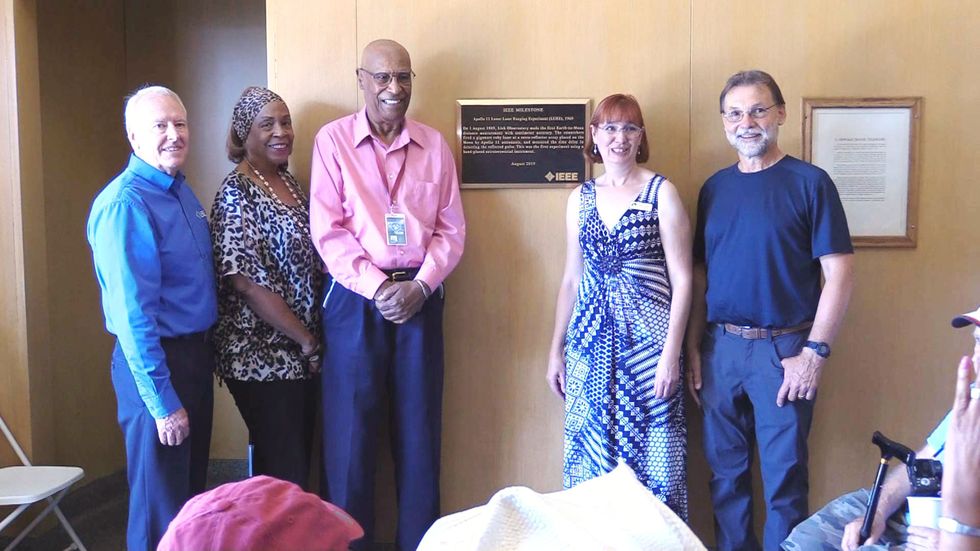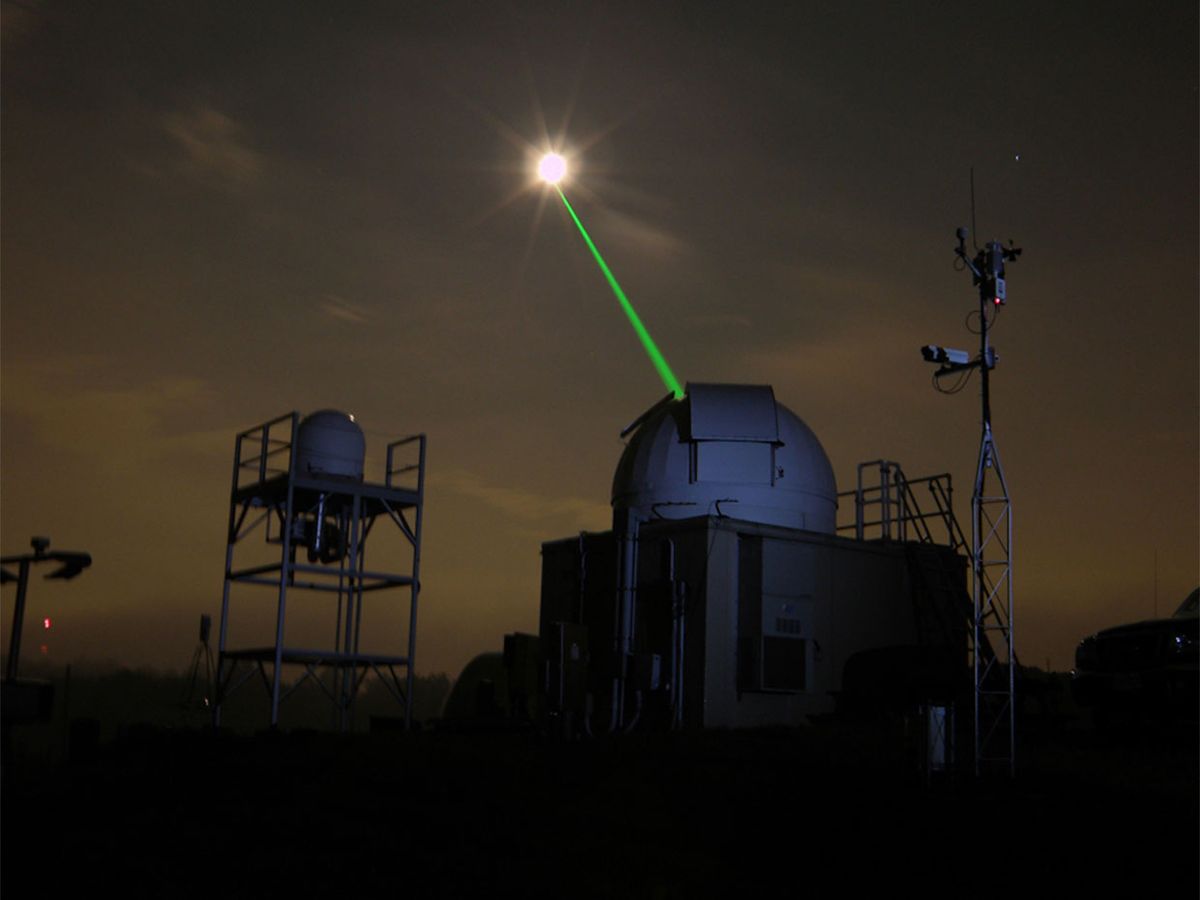THE INSTITUTEIf nothing else will convince someone that humans once walked on the moon, NASA’s lunar ranging experiment (LURE) should. It’s because of that experiment that scientists know the precise distance between the Earth and the moon with centimeter accuracy.
The LURE’s first demonstration began on 1 August 1969, when a pulse of trillions of photons was shot out of a telescope at Lick Observatory on Mount Hamilton, outside of San Jose, Calif. The laser pulse traveled to the moon and returned after reflecting off a 1-meter-wide array of mirrors—retroreflectors—that Apollo 11 astronauts had placed on the lunar surface 12 days earlier.
The Apollo 11 LURE was dedicated as an IEEE Milestone on 1 August—the 50th anniversary of the experiment’s first success—at Lick Observatory. The IEEE Santa Clara (California) Valley Section sponsored the Milestone.
In the five years that followed that 1969 experiment, other missions, such as Apollo 14 and 15 in 1971, placed additional mirror arrays on the surface.
The arrays have shown that the distance to the moon increases by about 1.5 inches per year.
The information collected from the experiment has allowed researchers to better understand changes in Earth’s rotation and has improved their knowledge about continental drift. It also has provided additional evidence supporting Albert Einstein’s general theory of relativity, which accounts for gravity.
Lunar laser ranging is still performed routinely today to track the moon’s orbit and variations in its rotation.
SHOOTING LASERS
When planning the Apollo 11 mission to the moon, NASA researchers decided to perform a few experiments. The LURE was meant to investigate fundamental aspects of gravitation. The agency hired two contractors, Spacerays and KORAD Laser Systems, to build the high-powered laser system that would be used for the experiment.
In an article on the website of the University of California, Santa Cruz, Joseph Wampler, a liaison between NASA and Lick Observatory, said the former was worried that when the Apollo astronauts left the moon, their rocket exhaust would leave the retroreflector array covered with dust. Because of that concern, between the two companies, four teams were given a laser system in hopes that one of them would be able to complete the experiment successfully. KORAD hired Hildreth “Hal” Walker Jr., a power electronics engineer, to manage one of its teams. Walker, who worked for Union Carbide’s laser systems division, was an expert in testing and manufacturing high-voltage and high-powered electronics.

The two Spacerays teams were located at the McDonald Observatory, owned by the University of Texas at Austin and located near Fort Davis, and the Haleakala Observatory, owned by the University of Hawaii and located in Kula. KORAD’s laser teams were located at Lick Observatory.
On 20 July 1969, the Apollo 11 astronauts landed on the moon and mounted the mirror array in the Sea of Tranquility. According an article by Brian J. Hagerty in Optics & Photonics News, the array’s exact coordinates in the Sea of Tranquility were unknown. Therefore, the four teams began to shoot lasers from their respective sites at what they estimated was the correct location, hoping to hit the retroreflectors.
Walker’s KORAD team encountered a problem with its laser system. According to the Optics & Photonics article, it failed due to the effects of the laser on the surrounding air. The air disturbance “fried” the electronics, Hagerty said. Walker drove from Lick Observatory to KORAD’s headquarters in Santa Monica, Calif., and back—more than 500 kilometers each way—to pick up replacement parts.
During the attempts to complete the experiment, it became apparent to the U.S. scientists scrutinizing the Sea of Tranquility that someone else on Earth also was firing a laser at the moon and attempting to hit the LURE array, according to Hagerty.
“Those rogue laser shots, it turned out, were from a team of Soviet scientists, who hoped to achieve an end run around the U.S. groups,” he wrote.
A few days after the equipment failure, on 1 August, Walker’s team detected a handful of photons that reflected back from the retroreflector array, dramatically improving the accuracy of the measured distance between the Earth and the moon. It took about 2.4 seconds for those photons to make the round trip.
Approximately 300 people attended the IEEE Milestone ceremony, organized by Brian Berg, IEEE Region 6 history chair and milestone coordinator. They heard from several speakers including Walker.

“The IEEE Milestone dedication highlighted the little-known story of Walker, who was a hidden figure who installed, operated, and fired the gigawatt-powered weapons-grade laser that produced the first accurate measurement of the distance from Earth to the moon,” Berg told The Institute. “It also honored the many individuals who came together for this experiment, which achieved its first success 12 days after man first walked on the moon.”
STILL RELEVANT
The LURE is still performed today in observatories all around the world, including in France, Germany, Italy, and the United States.
According to an article published last month on the NASA Jet Propulsion Laboratory website, the data gathered from the experiment continues to give researchers insight into the moon as well as Earth. In 1989, for example, researchers discovered that the lunar core is fluid—which suggests that the moon once might have generated and maintained its own magnetic field, just as the Earth does.
NASA has approved a new generation of reflectors to be placed on the lunar surface, according to the article. That would allow researchers to further investigate the moon’s history, study the fluid core, and help support future human exploration.
A plaque honoring LURE, mounted in the lobby of the Shane Dome at Lick Observatory, reads:
On 1 August 1969, Lick Observatory made the first Earth-to-Moon distance measurement with centimeter accuracy. The researchers fired a gigawatt ruby laser at a retroreflector array placed on the Moon by Apollo 11 astronauts, and measured the time delay in detecting the reflected pulse. This was the first experiment using a hand-placed extraterrestrial instrument.
This article was written with assistance from the IEEE History Center, which is funded by donations to the IEEE Foundation’s Realize the Full Potential of IEEE campaign.
Joanna Goodrich is the associate editor of The Institute, covering the work and accomplishments of IEEE members and IEEE and technology-related events. She has a master's degree in health communications from Rutgers University, in New Brunswick, N.J.



